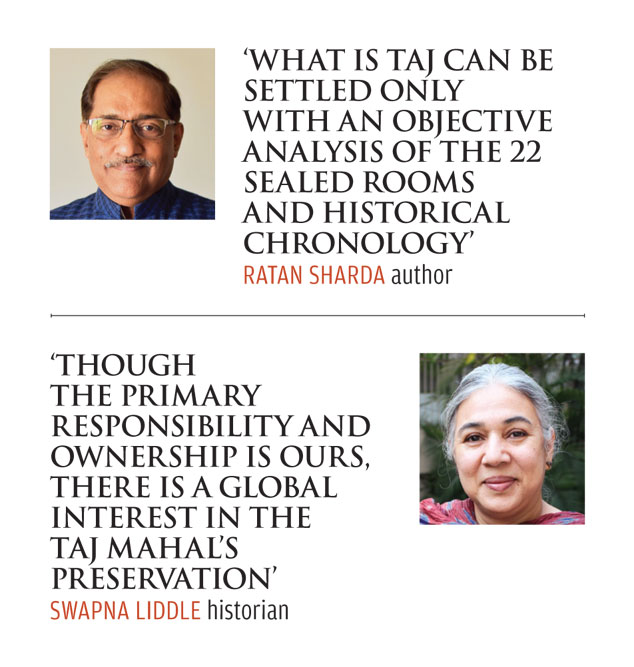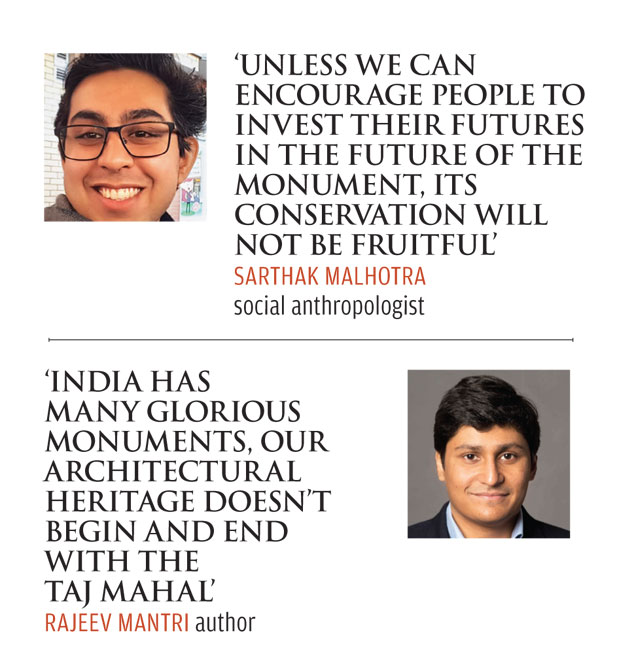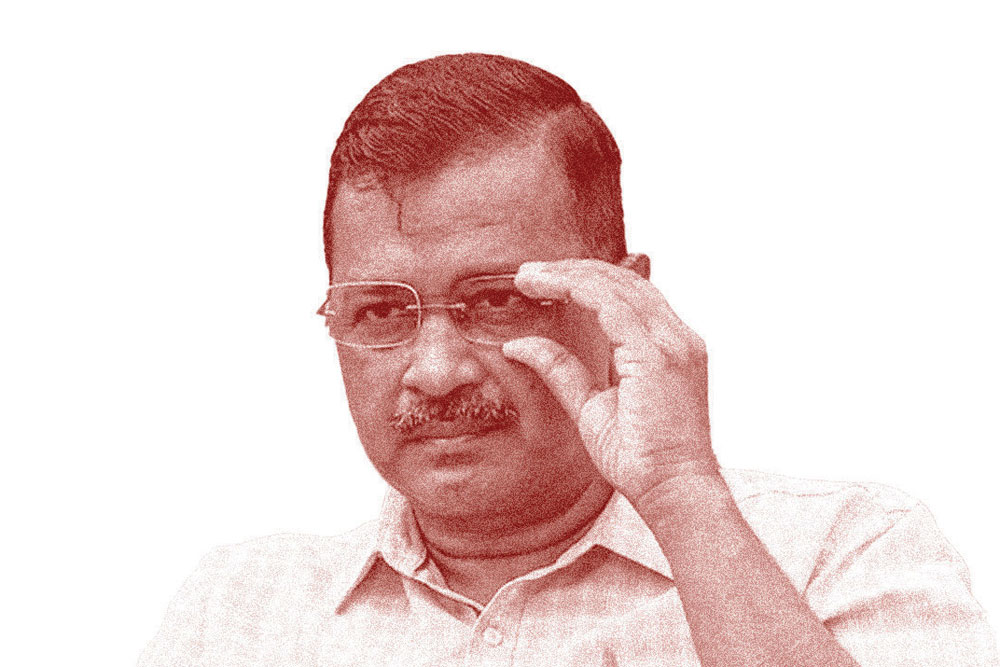For the Love of the Taj
Is the revisionist appraisal of the country’s most celebrated monument dislodging it from its cultural perch?
 Kaveree Bamzai
Kaveree Bamzai
 Kaveree Bamzai
Kaveree Bamzai
 |
03 Jun, 2022
|
03 Jun, 2022
/wp-content/uploads/2022/06/Taj1.jpg)
A painting of the Taj Mahal by Vasily Vereshchagin
THE PETITION IN the Allahabad High Court to establish a “fact-finding committee to study and publish the real history of Taj Mahal” and seek “to open the sealed doors” was not the first time the country’s most famous monument was under attack. Although the high court dismissed the petition by Rajneesh Singh, media-in-charge of the Bharatiya Janata Party (BJP) in Ayodhya, the 17th century monument is an old hand at courting trouble. Since its construction in 1632-53, it has had Jats taking away its silver doors in 1784, British Commander-in-Chief Lord Lake’s soldiers stripping it of the finials and pietra dura inlay in 1803, an attempt at auctioning by Governor General Lord Bentinck in 1833, a petition in 2015 by seven lawyers before a civil judge in Agra asking for Hindus to perform aarti inside the premises, and in 2017, a request to the government from the Central Information Commissioner to declare whether the monument is a mausoleum or a temple.
Much of this theorising about the Taj Mahal being a temple originally comes from the late maverick historian Purushottam Nagesh Oak who first wrote about the Taj Mahal being Tejo Mahalaya in 1965. Oak, who founded the Institute for Rewriting Indian History in 1964, provided a rich harvest to all kinds of theorists who would like to believe that the tomb was built on the remains of a Shiva temple. This discourse denies Taj’s heritage as Shah Jahan’s ode to his beloved wife Mumtaz Mahal, and a symbol of love for people across the world. It denies Taj’s World Heritage status granted by UNESCO in 1983. It also denies its contribution to Agra’s economy as the most visited monument in the country.
Among the many conspiracy theories, the latest included in Rajneesh Singh’s petition centres around 22 locked rooms in the tomb, which the Archaeological Survey of India (ASI) has now opened. Rashtriya Swayamsevak Sangh (RSS) member and author Ratan Sharda says: “What is Taj, what was its original idea and purpose, can be settled only with an objective analysis of the 22 sealed rooms and historical chronology. No nation is afraid of history or truth. No nation puts a lid on its past. We have to come out of it.”
But historians and conservationists say there is nothing really mysterious or sinister about the locked rooms. The Taj Mahal is a riverfront building, and every riverfront building in Agra had subterranean chambers. There are painted corridors leading down (or up for Shah Jahan) from the lower platform of the Taj. These, says conservationist Amita Baig, were undoubtedly the passages used by Shah Jahan who arrived at the Taj Mahal’s northern face by river from the Agra Fort, entered the Taj through a small door and into these passages. These passages gave him access to the crypt which was only sealed after his death. From here the royal family also had access to the main mausoleum where prayers were read round the clock.
As for the theory of the Taj being Tejo Mahalaya, Mughal court documents from Shah Jahan’s reign refer to the Taj Mahal by its official name, the Rauza-e-Munawwara, or the Illumined Tomb; the term “Taj Mahal” comes from a corruption of Mumtaz Mahal’s name. Early European visitors to Agra refer to the tomb as “Taj Mahal”. A map of Agra in the Jaipur City Palace made in the 18th century calls the Taj Mahal “Rauza-e-Shah Jahan” (Shah Jahan’s Mausoleum); while a map made in circa 1830s, the so-called “Agra Scroll” in the British Library, calls the Taj Mahal “Taj Bibi ka Rauza” (Tomb of the Lady of the Taj). There are two temple ghats on either side of the Taj Mahal and it is likely there would have been a domestic shrine within the mansions that Shah Jahan acquired to construct the mausoleum, but there is no historical record, Mughal or otherwise, that says there was a temple at the site where the Taj Mahal stands today, says social anthropologist Sarthak Malhotra.
But Sharda says that he has seen a well-researched PowerPoint with alleged evidence. “I have seen an interview of an American architect who has done carbon dating and features that make it look like a palace, not a tomb. So far, his talk is most convincing. I am not very sure if it is a temple but surely it doesn’t seem to be a building made for a tomb. This needs rooms and basements opened. The Taj Mahal is a perfectly symmetrical building with has coffins breaking the symmetry. It is stunning. Why would a sombre tomb have a music room (nakkar khana)? The chronology of this structure is also puzzling. This tells me it was not supposed to be a tomb.” It is not a Hindu-Muslim issue, for him, but invaders usurping our assets, work and culture.
It is important to remember the Taj is an early modern monument, a mere 350 years old, and that the Mughals were excellent record-keepers. As Austrian conservationist Ebba Koch’s masterly work, The Complete Taj Mahal and the Riverfront Gardens of Agra (2006), shows, the Mughals recorded each and everything used to construct it, from the land needed for it to the stones used. The land, as Diya Kumari (now Rajsamand MP for BJP) has said, did indeed belong to her ancestor Raja Jai Singh of Amer (now known as Jaipur state). It was the first Rajput house to cooperate with the Mughals under Akbar. Shah Jahan bought the land for the Taj in exchange for four other mansions from their crown estate. Jai Singh was also related to Shah Jahan through close marriage ties. His great-grandfather Man Singh’s sister was one of the wives of Shah Jahan’s father, Jahangir.

There are also records of all the material used in the construction of the Taj Mahal, from the marble to the bricks, from the sandstone to the polished plaster. Nor was it built in isolation. When Babur took Agra in 1526, he initiated a remodelling of its urban landscape to resemble the Timurid gardens. Though only traces remain of Babur’s first garden, the Chahar Bagh almost opposite the Taj Mahal, it inaugurated a new type of riverfront garden planning. When Akbar moved the capital back to Agra in 1558, the town grew in size, wealth and power, says Koch.
As Baig and architect Rahul Mehrotra write in their well-regarded Taj Mahal: Multiple Narratives (2017), 400 years ago Agra was considerably more cosmopolitan than it is now; the emperor’s omrahs were not only Mughal but also Persian and Turkish. During Shah Jahan’s reign, Agra was a sophisticated city to which travellers and merchants from around the world gravitated. “Purveyors of exotic goods presented themselves at the court of the emperor. From Portuguese Jesuits to itinerant English traders, all were mesmerised by the scale and grandeur of the Mughal capital, previously unknown to them. When William Finch arrived in Agra in 1611, he was greeted by an English mercenary, three French soldiers, a Dutch engineer, and a Venetian merchant!” This is the key. Agra, which Shaj Jahan renamed Akbarabad in honour of his grandfather, was a cosmopolitan capital much admired by travellers of the time, such as French physician François Bernier and Jean de Thévenot, who admired its riverfront palaces. The city’s decline began when Shah Jahan moved the court to Shajahanabad in Delhi and was thereafter imprisoned in the Agra Fort by his son Aurangzeb until he died in 1666. It was exacerbated when the British took over in 1803. As Koch writes, in the 20th century the original urban landscape of Mughal Agra was largely forgotten and absorbed by the ever-expanding city.
All the debilitating problems the Taj suffers from date back to this. These require well-thought-out and holistic solutions to many problems: a severely polluted Yamuna, poor air quality, and a staggeringly high volume of visitors (eight to nine million a year compared to Agra’s population of 4.4 million) whose presence is damaging the Taj’s architecture. It involves spending a lot more money on conservation—perhaps a share of what the Taj Mahal earns the government—and on the latest methods and technologies in conservation. As Malhotra points out: “We also need to have a serious discussion on what conservation really means and for whom the monument is a meaningful place. The Taj Mahal without the people of Taj Ganj or Agra is meaningless; unless we can encourage people to invest their futures in the future of the monument, its conservation will not be fruitful.”
The Taj Mahal was ransacked many times in its history—by the Jats, the Marathas and the British. But the British also took considerable interest in the preservation of buildings. The Taj Mahal that we see today, notes Malhotra, is a product of British imperial design that dismantled Mughal ideas of what a sacred funerary site should be by transforming it into an elegant English park where the focus of the visitor changes from praying for the souls of the dead to experiencing pleasure in a touristic way. Under Maratha control, the Taj Mahal became a place for honeymoons and picnics; the Scindias of Gwalior even threw a lavish party at the Taj where Englishmen and women danced the quadrille as brass bands played on the marble platform. This changed with Lord Curzon’s interventions: he cleared the bazaar from the precincts of the Taj Mahal, restored ruined architecture, and most notably redesigned the garden altering the Mughal charbagh and giving us the view that we are now so familiar with.

WHILE THE TAJ MAHAL is well preserved and cared for, says Baig, the environment continues to be a concern. Until the city achieves a much higher standard of civic responsibility, ASI cannot do much more. The gardens and water system require a more profound understanding so they can reflect the original intent. It is not just a question of funds, although that is a factor as well. A report in 2019, quoting data from the minister of state (independent charge) for tourism and culture in Lok Sabha, revealed that the monument earned over `200 crore through ticket sales in the preceding three years, but the government spent only `13.37 crore for its conservation.
The bigger problem is of the multiplicity of authorities. The Agra Development Authority (ADA) collects a tax on every ticket ASI sells; so, for a general admission ticket to the Taj, which is `50, ASI takes `40 and ADA `10. This city agency earns in crores and spends money on developing tourism infrastructure. The problem with the Taj is that there are at least a dozen city, state, Central, and even global, institutions working there. Says Malhotra: “We really need to fundamentally change the conversations we’re having about heritage monuments: How do we stop privileging tourists over local populations?”
It is a question addressed in Taj Mahal: Multiple Narratives. What would it take to restore the Agra riverfront to the Mughal days with 44 riverfront aram baghs? Mehrotra believes that part of the reason Agra city did not identify with the Taj Mahal through history is because the aram baghs were pleasure gardens for the elite and remained removed from the common people. Not just that—the writers believe the Taj has a future only if Agra can be seen in the wider context of Mathura and Vrindavan.
But the biggest threat yet to the Taj may be the widespread questioning of the monument’s contribution to India’s cultural heritage. Taj Mahal symbolises everything that is India—built by a Muslim emperor born of a Hindu mother and restored to somewhat of its former glory by an Englishman. By constantly undermining it, the revisionists are dislodging the Taj’s historic role as a symbol of a syncretic Indian culture (both within India and globally) and associating it with Islam to delegitimise its Indianness.
As historian Swapna Liddle says: “The Taj is not only a national treasure but is recognised by UNESCO as World Heritage, which is of global value. Though it lies within India’s boundaries and the primary responsibility and ownership is ours, there is a global interest in its preservation.” Indeed, the Taj Mahal cannot be without controversy because it is so central to our nation-building, points out Malhotra. “There are as many Taj Mahals as there are people who visit or live near it: we need to understand what the monument is, how it can be used as a tool for future-making for the Agra people, and not waste our time talking about issues that frankly legitimise fringe statements that should have no place in the public discourse,” he adds.
The co-author of A New Idea for India, Rajeev Mantri, agrees that claims and counter-claims on the Taj Mahal undermine the credibility of those issues that deserve serious consideration and debate. “The Taj Mahal is a beautiful structure and certainly one of the monuments representing India, but over the years for some reason it has come to occupy a disproportionate mindspace. India has many other glorious monuments, our architectural heritage doesn’t begin and end with the Taj Mahal,” he says.

/wp-content/uploads/2025/01/Cover_Kumbh.jpg)










More Columns
The lament of a blue-suited social media platform Chindu Sreedharan
Pixxel launches India’s first private commercial satellite constellation V Shoba
What does the launch of a new political party with radical background mean for Punjab? Rahul Pandita